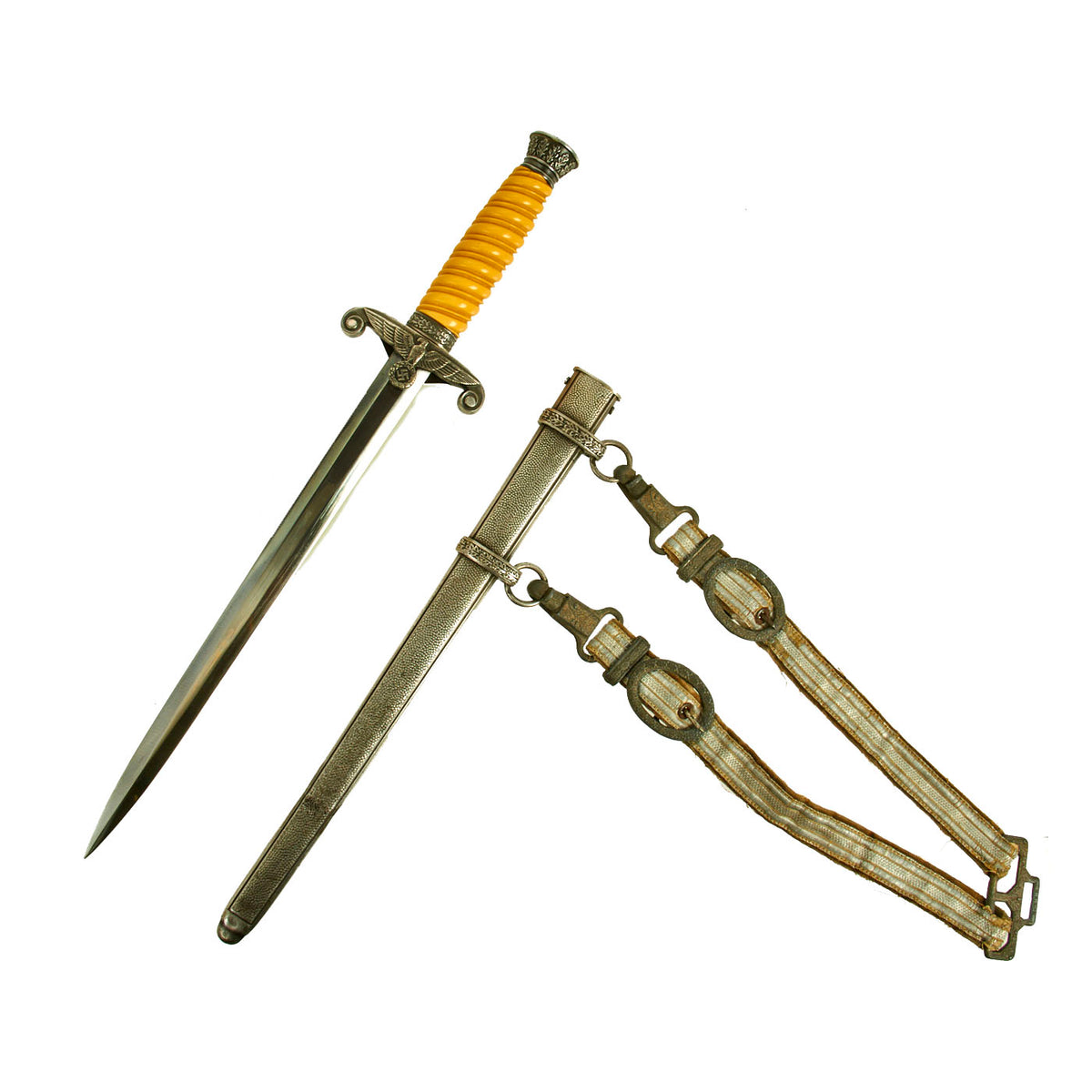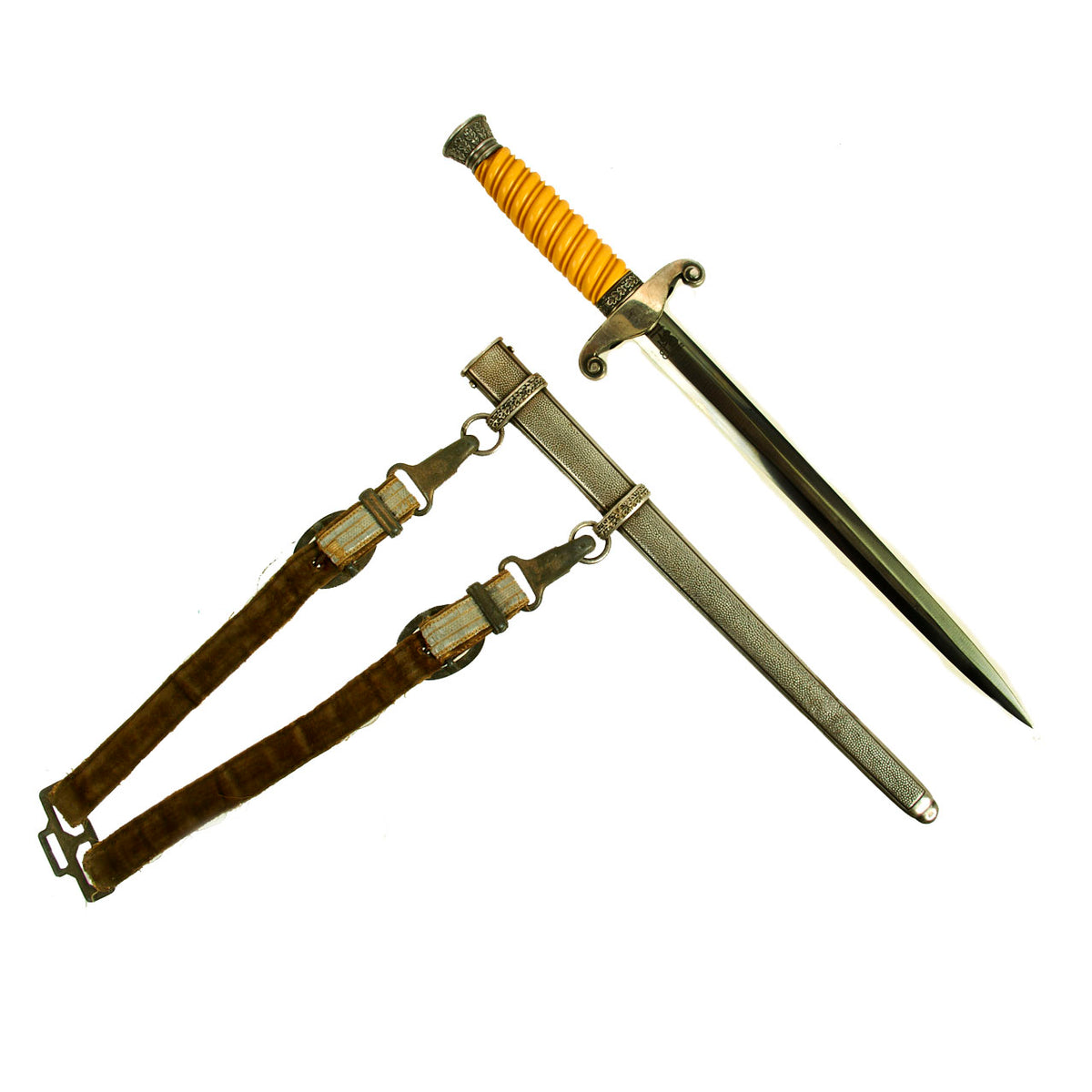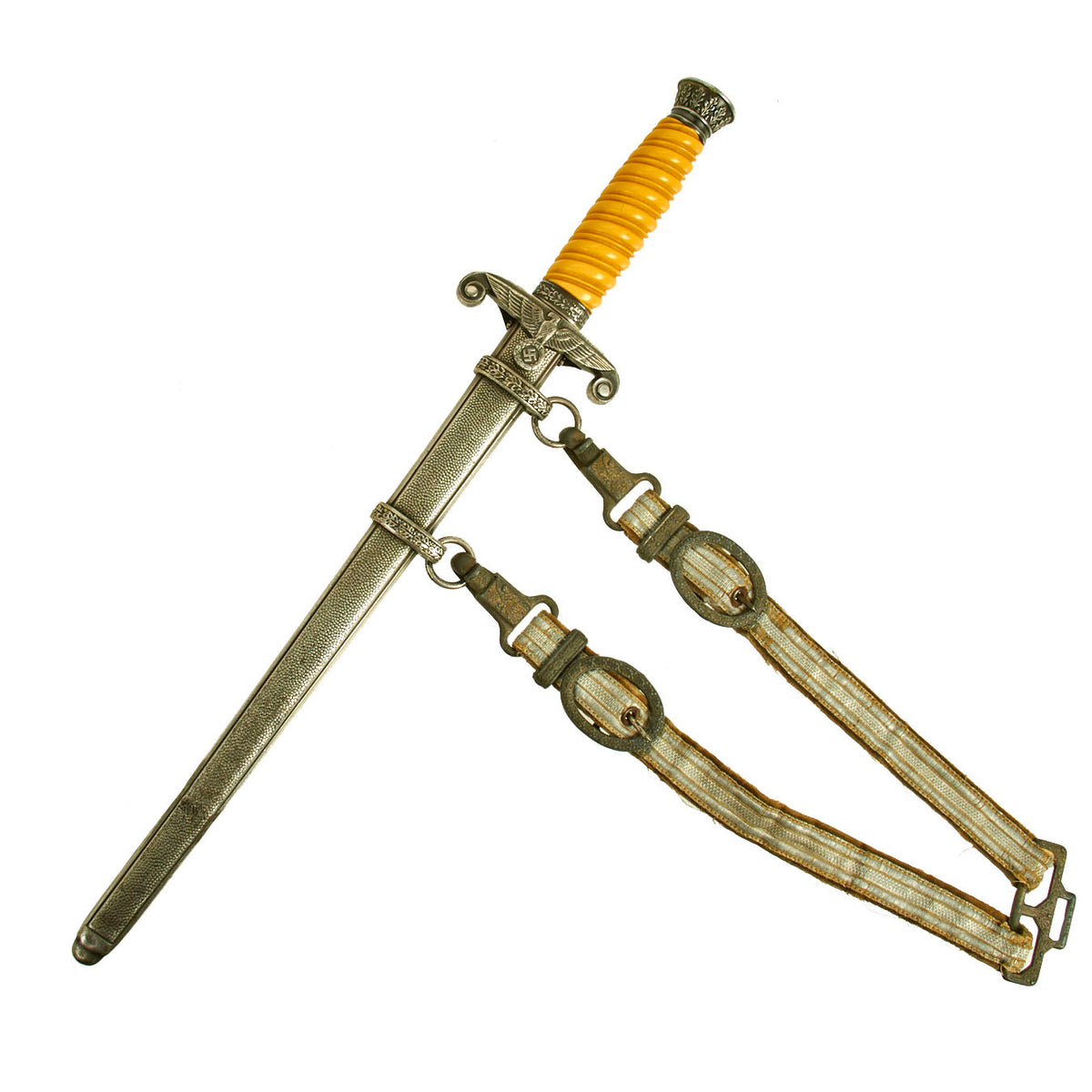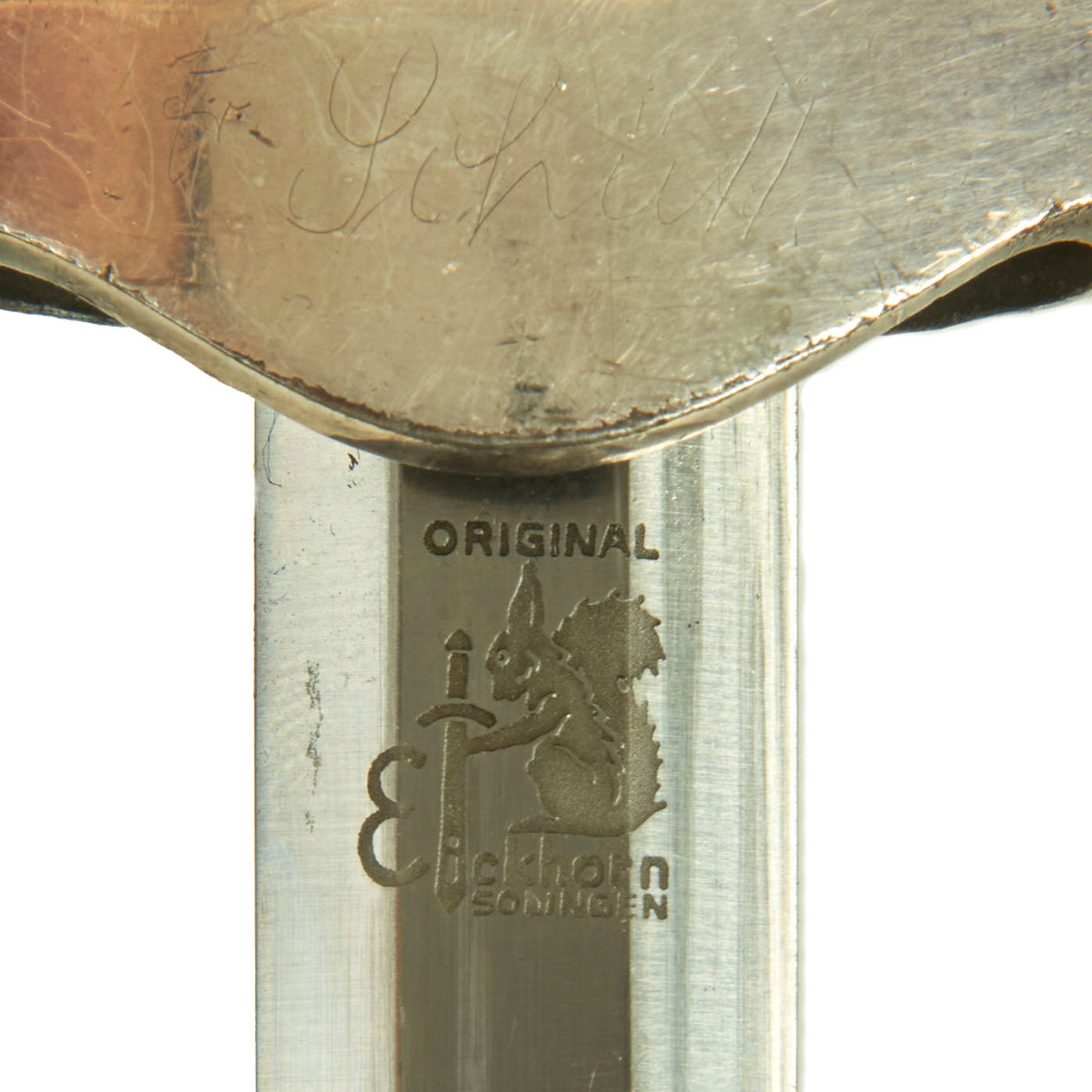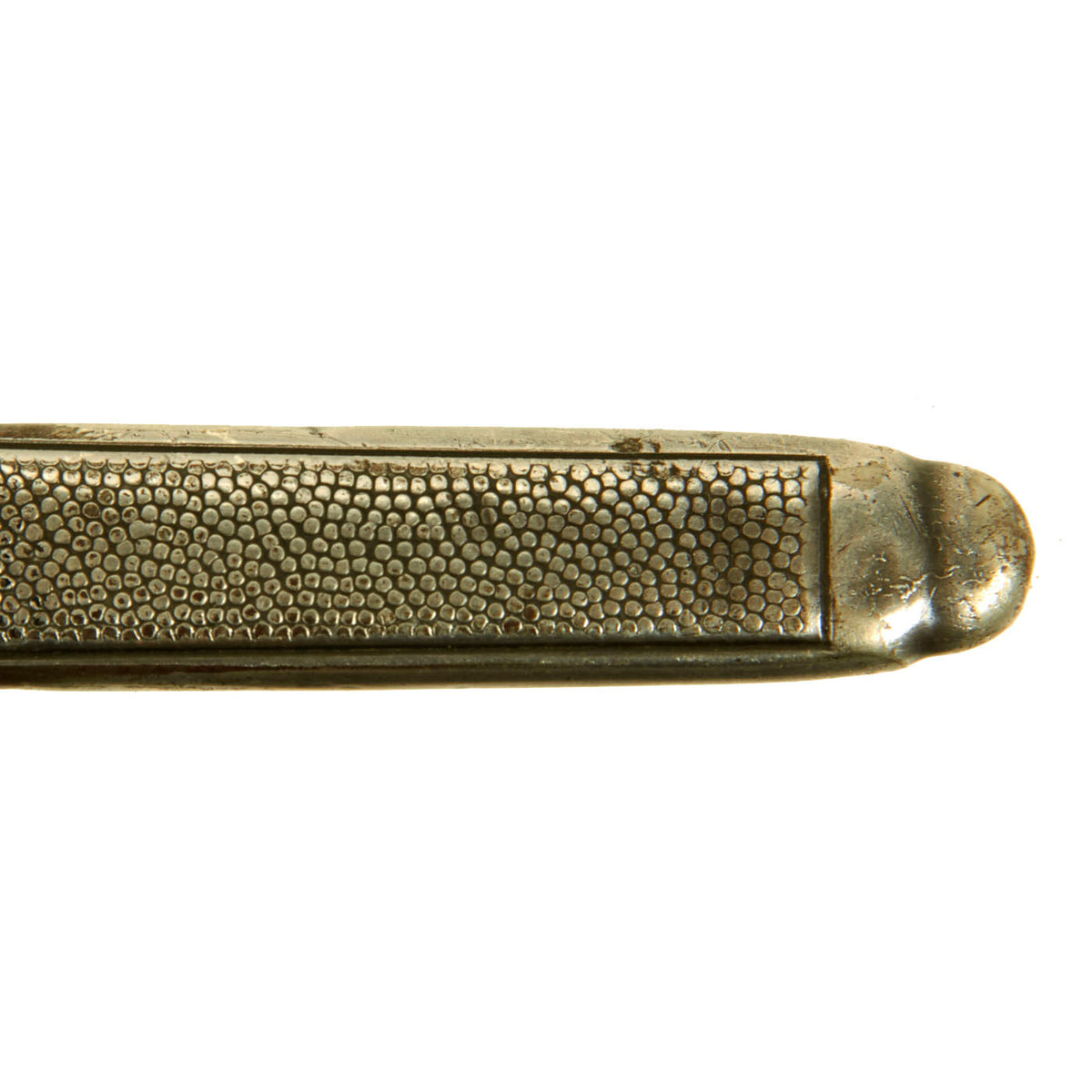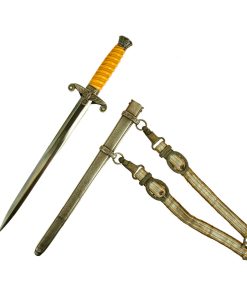Original German WWII Army Heer Officer Dagger by Carl Eickhorn with Belt Hanger & Scabbard Original Items
$ 995,00 $ 248,75
Original Item: Only One Available. This is a great Army Officer’s Dagger, produced by the legendary Solingen-based firm Carl Eickhorn. The alloy pommel of this dagger is in good condition, showing light wear and scratching throughout the bottom, with much of the plating visible. It has a nice aged patina throughout, and the standing oak leaves and acorns are crisply detailed and have good backgrounds.
The plated crossguard is in great shape, still mostly shiny, with the correct darkening in the recesses of the design. The details throughout the characteristic eagle are exceptional throughout the head, breast and wing feathering, talons and wreathed mobile swas. Additionally, the reverse of the cross guard has been personalized very lightly with the German surname Schütt in cursive script. The grip ferrule is plated zinc alloy, and looks great, with a lovely dark patina on the plating.
The grip has faded to a lovely yellowed ivory color, due to exposure to the light. This is typical of celluloid grips from this period, however usually they fade a lot more to orange, so this is definitely a nice example. This grip is in very good condition throughout, with just a bit of wear and small scratches, and a bit of chipping near the pommel.
The blade on this example is excellent NEAR MINT condition. It is probably the best blade we have sever seen on a German dagger. The factory final grind crossgrain is completely present, and there is very little wear of any kind, just a tiny bit of the usual runner wear. There are just one or two tiny spots of oxidation, and the edge is correctly unsharpened. The tip has a miniscule bend on the very apex of the blade edge. Truly a great blade!
The rear of the blade is etched with the 1935-41 Eickhorn trademark: a seated squirrel holding a sword, with the word ORIGINAL above and the firm’s name and location, Eickhorn / SOLINGEN below. Carl Eickhorn is a legendary maker from Solingen, the famous “City of Blades” in Western Germany.
According to J. Anthony Carter’s book, GERMAN KNIFE AND SWORD MAKERS, this company was founded in 1865 by Carl Eickhorn, and is arguably the most famous of all Solingen makers. Not only could the family trace their history back 500 years, but they could also demonstrate involvement in the hardening and grinding industries for the same period. Truly the nobility of Solingen Edged weapon dynasties. Eickhorn edged weapons are the most desirable of all makers. The original leather blade buffer is in place within the deep recesses of the guard.
The scabbard is a fine example, and is plated steel. There is what looks to be a crush/bend do the scabbard about 2 inches above the bottom.
This scabbard has very crisp, finely pebble grained panels, which are well retained. The carrying bands have a very nice oak an acorn motif, a common design seen on German edged weapons.. The throat is the thinner style, and is secured by two cheese-headed securing screws on the narrow sides of the scabbard. The finish looks to be silver or nickel, and is in good shape, having been kept polished over the years.
Attached to the scabbard is a very good condition belt hanger, with functional pebbled spring clips with a great patina. The end clips are the more complex and desirable sliding type. The buckles and keepers are engraved with the same oak and acorn motif seen throughout the dagger. The hardware is marked D.R.G.M, indicating that these were registered in the German trademark office. The straps are in good condition, with velvet on the back, though they do show wear on the edges.
A great example from a legendary maker, complete with scabbard and hanger! Ready to display!
Specifications:
Blade Length: 9 1/2″
Blade Style: Spear Point Dagger
Overall length: 14“
Crossguard: 2 3/4”
Scabbard Length: 11 1/8″
The German Army (Heer) first carried a dagger beginning in 1935. The weapon was worn in lieu of occasions not demanding the wearing of a more formal sword. The dagger design was quite attractive featuring silvered heavy fittings with white or colored grip. The crossguard depicted a Wehrmacht open-winged eagle clutching a wreathed swas.
The pommel depicted oak leafing around the outer circumference. The scabbard had panels of pebble designs. Later produced examples were plated with nickel, and late war-made pieces were unplated, finished in a gray color metal. This early war version is quite nice, and in great shape.
Fast Shipping with Professional Packaging
Thanks to our longstanding association with UPS FedEx DHL, and other major international carriers, we are able to provide a range of shipping options. Our warehouse staff is expertly trained and will wrap your products according to our exact and precise specifications. Prior to shipping, your goods will be thoroughly examined and securely secured. We ship to thousands clients each day across multiple countries. This shows how we're dedicated to be the largest retailer on the internet. Warehouses and distribution centres can be located throughout Europe as well as the USA.
Note: Orders with more than one item will be assigned a processing date depending on the item.
Before shipping before shipping, we'll conduct a thorough inspection of the items you have ordered. Today, the majority of orders will be delivered within 48 hours. The delivery time will be between 3-7 days.
Returns
The stock is dynamic and we cannot completely manage it because multiple stakeholders are involved, including our factory and warehouse. So the actual stock may alter at any time. It's possible that you may not receive your order once the order has been made.
Our policy is valid for a period of 30 days. If you don't receive the product within 30 days, we are not able to issue a refund or an exchange.
You can only return an item if it is unused and in the same state as the day you received it. You must have the item in its original packaging.
Related products
Uncategorized
Uncategorized
Angolan Rebel 1970s era 60mm Inert Display Mortar from Angolan Civil War Original Items
Uncategorized
Uncategorized
Uncategorized
Uncategorized
Uncategorized
Uncategorized
Uncategorized
Uncategorized
Australian WWII Owen MK1 Machine Carbine SMG Custom Fabricated Replica with Sling Original Items
Uncategorized
Uncategorized
Uncategorized
Uncategorized
Uncategorized
Uncategorized
Uncategorized
Uncategorized
Uncategorized
Armored Burgonet Helmet & Polearm from Scottish Castle Leith Hall Circa 1700 Original Items
